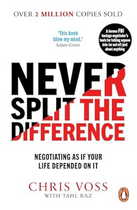Never Split the Difference - Negotiating as if Your Life Depended on It
I did the audio version of the book and was initially put off by the narrator’s dramatic voice. I decided to ignore the nasal accent and pay attention to the content, and I am happy that I persisted. This book is a treasure. I like how it combines crime scenes and professional as well as personal scenarios. The concepts of behavioral economics – loss aversion, anchoring bias, and more – are explained very well through the real-life crime and drama stories.
I read my first behavioral psychology book in 2020. It was Daniel Kahneman’s Thinking, Fast and Slow. The book was a difficult read with its numerous theories and explanations, and I had to read it twice to understand many parts of it. The fact that I did read it twice made me love this subject very much. In the last few months, I have read several books that time and again refer to Kahneman’s work and highlight several parts of it. I think Never Split the Difference has a lot of ideas from this book and presented it in its own way. well.
Key Takeaways
-
Accepting “No” for an answer
Not seeing it as the end of the conversation. Many of us dread hearing “No,” but Chris Voss explains how “No” is basically the safety blanket that our counterpart uses. Once said, it relaxes the conversation, and you can use it to get more out of the deal. -
There is no Win-Win
I agree with this for many cases. Compromise always leaves a sour taste, but it is necessary. However, it is important not to compromise too early. -
Importance of active listening
This is the most challenging part. To sit back and listen, pause, listen deeply, and hear what is not being said. -
Getting the “That’s right” answer
Asking the how and what questions instead of the why questions. I tried this out on my teenage son and was surprised that it worked. -
“Being you is not the normal”
When selling a product or service, it is important to ask yourself if you would buy the product or service you are selling to another. At the same time, it is very important not to project your reactions onto another. It is crucial to assess your counterpart and use the 7-38-55 principle. 7% is verbal (words used). 38% is vocal (tone, pitch). 55% is visual (body language). The importance of non verbal cues in communication. This was a new concept for me, but it makes a lot of sense. I should start embracing video calls more than phone calls and emails.
As a bonus, you can download several worksheet PDFs from Chris’s company website, Black Swan Ltd.
© 2025 Sindhuja Cheema Enzinger. All Rights Reserved.

